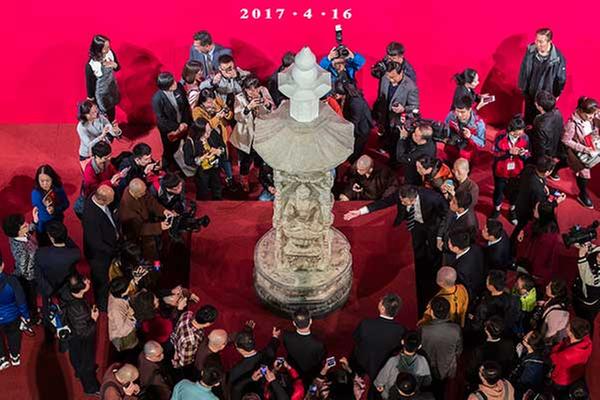Monastery returns pagoda body after 19-year nationwide search
By Wang Kaihao in Taiyuan | China Daily | Updated: 2017-04-17 07:32
 |
| A ceremony marking the return of a 1,300-year-old stone Buddhist pagoda body to its home in Shanxi province is held in the Shanxi Museum on Sunday. The top was taken first but has not been found, leading the museum to use a recreated top.[Photo by Hu Yuanjia/For China Daily] |
Nearly 20 years after being stolen, a 1,300-year-old stone Buddhist pagoda body has been returned to its home of northern Shanxi province with the best wishes from pilgrims across the Taiwan Straits, officials said Sunday.
The 1.77-meter-high component, a part of a 3.2-meter-high pagoda was located in Dengyu village in Shanxi province's Yushe county. Based on inscriptions on the pagoda, it appears to have been made in 720 AD. It was included in Shanxi's first provincial list of key protection cultural relics as early as in 1965. However, its top part was stolen in 1996, and the body became lost two years later. Its octagonal foundation and eaves were left at the site.
"It's rare to see such exquisite stone pagoda of the Tang Dynasty (618-907) in Shanxi, even though our province has abundant Buddhist cultural relics," said Shi Jinming, director of the Shanxi Museum, where a ceremony on Sunday was held to announce the pagoda body's return. The artifact was quietly returned to the museum in January.
"The figures are elegant and vivid," he said. "What the artifact reveals is the typically prosperous flavor during the zenith of the Tang Dynasty."
Four facades of the pagoda body were carved with Buddhist reliefs and decorated with color drawings. The inscriptions also include important historical information, Shi said.
In 2015, the pagoda body was donated by a private collector to Chung Tai Chan Monastery in Nantou county, Taiwan. Nevertheless, Abbot Wei Chueh, who since has died, founder of the monastery, showed willingness to return it via his delegates who visited the State Administration of Cultural Heritage in February 2016, noting "it was possibly an artifact stolen from Shanxi around 2000".
























